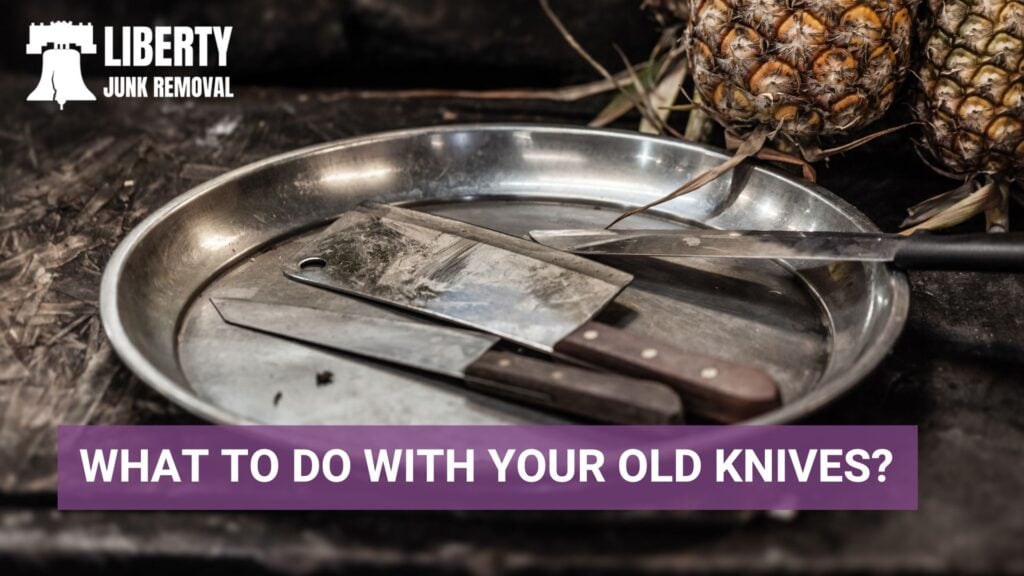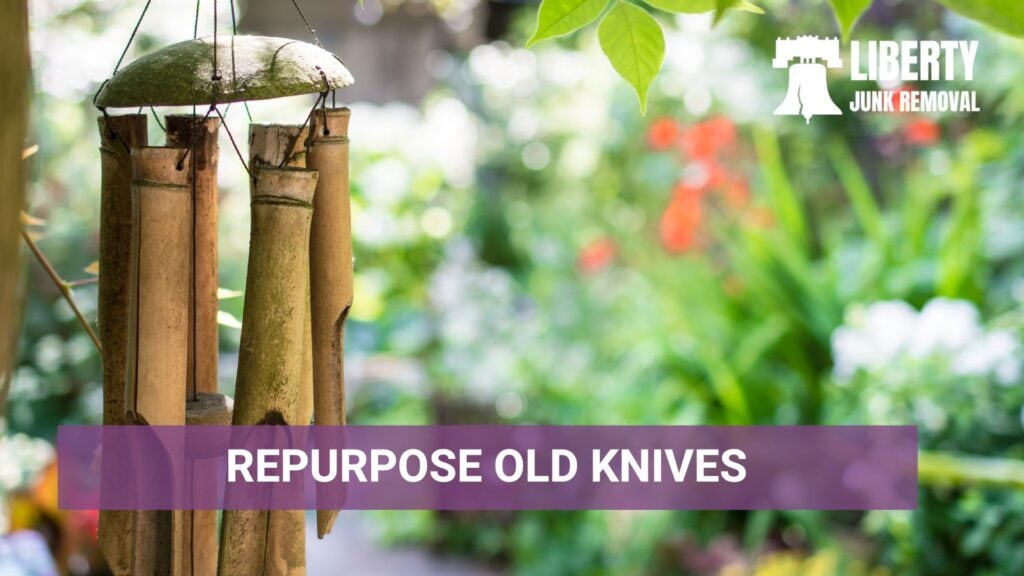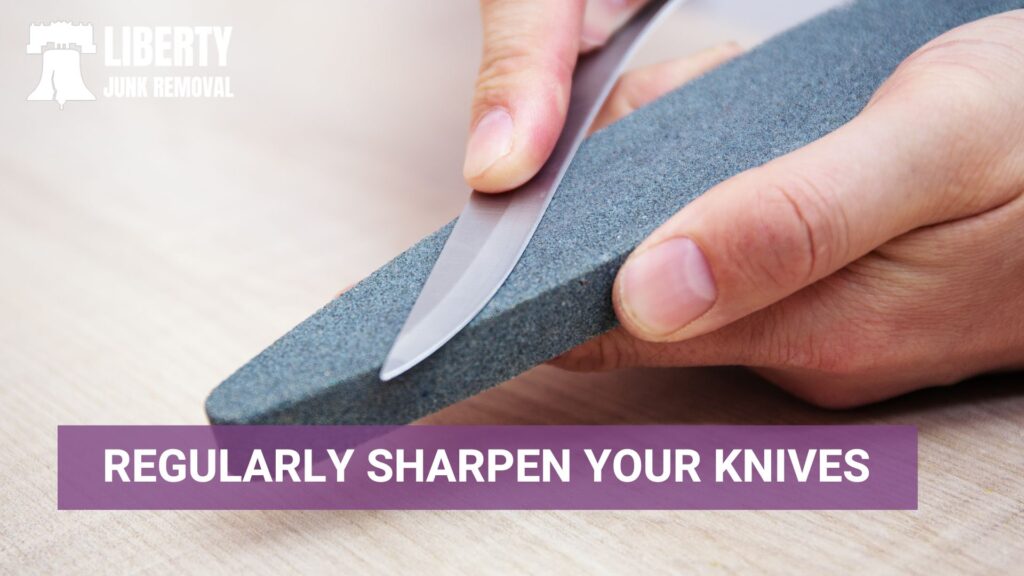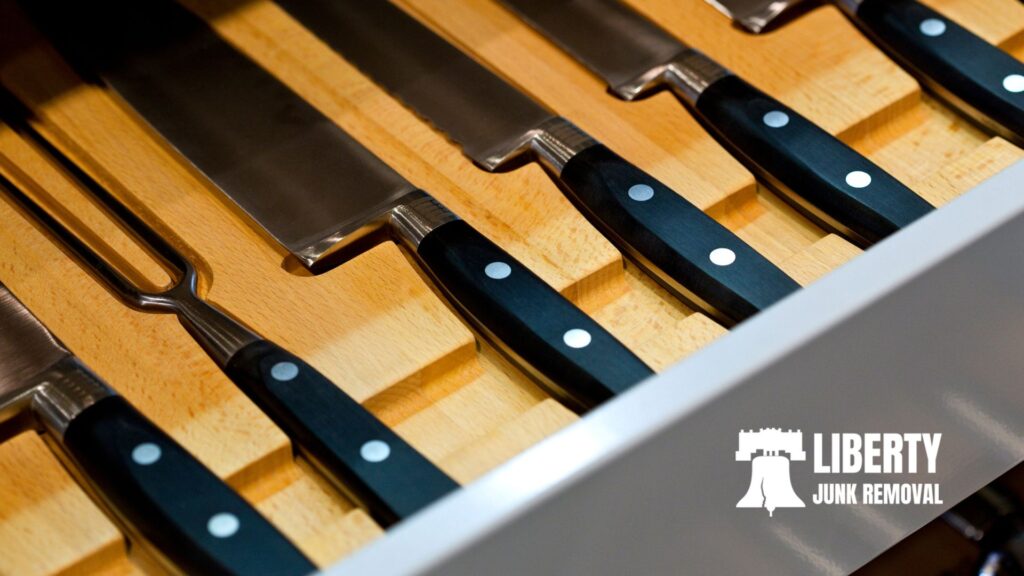Are you staring at a drawer full of old, rusty kitchen knives that have seen better days? Or maybe you’ve upgraded to a shiny new set, and the old ones are nagging you – “How to get rid of kitchen knives?”
As a quick guide, here’s what you need to know:
To safely dispose of kitchen knives, wrap them in cardboard or thick layers of newspaper, secure them with tape, and label them “Sharp” for safety. Place in a sturdy container and contact local disposal services for guidance on proper disposal or recycling options.
It’s time to learn more. In this post, we’ll show you how to safely and responsibly dispose of your old kitchen knives.
Safety Tips on How to Get Rid of Kitchen Knives

The thought of simply tossing your old knives in the trash might cross your mind, but there are more eco-friendly and sustainable ways to part with them, including the following options:
Donate or Sell Your Kitchen Knives if They Are Still in Fair Condition
If your knives are still in decent shape and could serve someone else well, consider donating or selling them.
Take Your Old Knives to a Scrap Metal Recycling Center
Many scrap metal recycling centers accept old knives. They’ll be melted down and given a new life as something entirely different.
Recycling metal is environmentally responsible, and it reduces the need for mining and processing new raw materials. Most kitchen knives are made of stainless steel, which is highly recyclable. According to the American Iron and Steel Institute, recycling one ton of steel can save over 2,500 pounds of iron ore, 1,400 pounds of coal, and 120 pounds of limestone.
Upcycle Your Old Knives into New Objects

Instead of discarding your old knives, consider upcycling them into new and functional objects. Turn them into stunning wall hooks, unique garden markers, or even a one-of-a-kind wind chime. It’s totally up to you and where your imagination takes you.
If you love DIY projects and hate seeing anything go to waste, upcycling your old kitchen knives into new objects is a creative and sustainable solution. Here’s how you can turn your knives into unique and functional items:
- Wall Hooks. You can attach the knives to a wooden board or a piece of reclaimed wood, creating a stylish and functional addition to your home.
- Garden Markers. Clean and decorate the handles, and then label them with the names of your plants or herbs.
- Wind Chime. Drill holes in the handles and blades, attach them to a piece of driftwood or a metal ring and hang them in your garden or on your porch.
- Art Pieces. Weld the old knives together, combine them with other found objects, or use them as sculptural elements in your artwork.
- Kitchen Décor. Mount them on a magnetic strip or frame them to create unique wall art. This way, they continue to be a part of your kitchen’s story.
Restore Your Dull Knives
Instead of tossing your dull knives, why not consider giving them a second chance through restoration?
- Honing vs. Sharpening
Honing is the process of realigning the blade’s edge while sharpening involves removing material to create a new edge. For slightly dull knives, honing might be sufficient.
- Honing Rod or Sharpening Stone
You can use a honing rod to maintain the edge of your knife between sharpening sessions. It straightens the blade and prolongs its sharpness. On the other hand, sharpening stones are used to remove material and reshape the blade. They come in various grits, with coarser stones for repairing damaged edges and finer ones for polishing.
- Professional Sharpening
If you’re unsure about sharpening your knives yourself, consider professional sharpening services.
- Electric Knife Sharpeners
These machines simplify the sharpening process, making it accessible to anyone. However, they can be abrasive and should be used carefully, especially on high-quality knives.
- Proper Technique
Regardless of the method you choose, it’s crucial to use the proper technique. Ensure a consistent angle while sharpening, and don’t rush the process.
- Regular Maintenance
After each use, wash and dry them by hand rather than in the dishwasher, as dishwasher detergent can be abrasive. Store them in a knife block, magnetic strip, or blade guard to protect the edges.
Throw Away Your Old Knives Safely
While we encourage recycling, upcycling, and restoring, there may be cases where your knives are beyond saving. Here are the options on what to do in this case:
- Secure the Blades
- Follow Local Regulations
- Locate the Nearest Recycling Center
- Consult with Local Waste Management
- Be Cautious with Household Waste
- Donate if Possible
Contact Your Local Scrap Metal Yard
If you’ve decided to dispose of your old kitchen knives and want to ensure they are recycled responsibly, contacting your local scrap metal yard is an excellent step. Scrap metal yards are experts in handling and recycling various types of metal, including stainless steel.
How Can I Maintain My Kitchen Knives To Avoid Disposal
Your kitchen knives are valuable tools that can last for many years with proper care. Let’s explore two essential aspects of knife maintenance: proper cleaning and storage.
Proper Cleaning
- Hand Washing. Avoid using the dishwasher, as the harsh detergents and high water temperatures can damage both the blade and handle materials.
- Immediate Cleaning. After using a knife, clean it immediately to prevent food particles from drying onto the blade.
- Use a Soft Cloth or Sponge. Avoid abrasive scrubbers or steel wool, as they can scratch the blade’s surface, making it more susceptible to corrosion.
- Mild Detergent. Use a mild dishwashing detergent and warm water to clean your knives. Avoid using bleach or harsh chemicals that can tarnish the blade or handle.
- Avoid Soaking. Do not soak your knives for an extended period, as this can lead to corrosion, especially if the knife has a high carbon content.
- Towel Dry Thoroughly
Proper Storage
- Knife Block or Magnetic Strip. Knife blocks keep blades separated and protect them from abrasion, while magnetic strips offer easy access and visibility.
- Blade Guards. If you prefer to keep your knives in a drawer, use blade guards to protect both the knife’s edge and your fingers from accidental cuts.
- Avoid Stacking. Stacking can lead to nicks and damage to the blades. If stacking is necessary, use blade guards or a soft material between them.
- Wooden Cutting Boards. Use wooden or bamboo cutting boards instead of hard materials like glass or granite. Softer cutting boards are gentler on knife edges and reduce the risk of premature dulling.
- Regular Honing. To maintain the sharpness of your knives, use a honing rod regularly. Honing realigns the blade’s edge, extending the time between sharpening sessions.
Sharpening Techniques for Kitchen Knives

Keeping your kitchen knives sharp is essential for efficient and safe food preparation. Here are the top suggestions on how to get this done:
- Using Sharpening Stones (Whetstones)
Sharpening stones, also known as whetstones, are one of the most traditional and effective ways to sharpen kitchen knives. They come in various grits, from coarse to fine. Coarser stones are for repairing damaged edges, while finer stones are for polishing and maintaining an already sharp edge. Start with a medium grit stone (around 1000-3000) if your knife is dull, and then move to finer grit (3000-8000) for finishing.
- Using Honing Rods (Sharpening Steel)
Honing rods are used to maintain the edge of a knife between sharpening sessions. They do not sharpen a dull blade but instead realign the edge.
- Using Electric Knife Sharpeners
Electric knife sharpeners are convenient and user-friendly. They use abrasive belts or rotating stones to sharpen knives. However, while electric sharpeners are convenient, they can be aggressive and remove more metal than necessary, potentially shortening the life of your knives. Use them judiciously and according to the manufacturer’s guidelines.

How to Choose Quality Kitchen Knives for Longevity
Selecting high-quality kitchen knives is essential to ensure they last for years and provide consistent performance. The longevity of your knives depends on various factors, such as::
Brand Reputation
Start by considering well-established brands known for their quality and craftsmanship. Before making a purchase, read reviews and testimonials from both experts and customers. Also, you can seek recommendations from professional chefs or experienced home cooks.
It’s also important to check if the manufacturer offers a warranty or guarantee for their knives. A good warranty can be a sign of the manufacturer’s confidence in the product’s durability.
Intended Use
Consider your cooking style and the tasks you frequently perform in the kitchen. Knives are designed for specific purposes, such as chopping, slicing, or filleting. Invest in knives that align with your culinary needs.
Handle Material
Knife handles can be made from various materials, including wood, plastic, stainless steel, and composite materials. Look for knives with ergonomic designs that reduce strain during prolonged use. A full tang knife, where the blade extends through the handle, is typically more durable and well-balanced than knives with partial tangs or rat-tail tangs.
Blade Shape
Different blade shapes serve different purposes. For example, a chef’s knife is versatile and can handle a wide range of tasks, while a boning knife is designed for precision work. Choose blades that align with your cooking needs.
Blade Material
- Stainless Steel vs. Carbon Steel. Stainless steel knives are resistant to corrosion and staining, making them low-maintenance. Carbon steel knives offer exceptional sharpness but require more care to prevent rust.
- High Carbon vs. Low Carbon. High-carbon steel blades are known for their sharpness and edge retention. Low-carbon steel blades are more flexible but may require more frequent sharpening.
- Forged vs. Stamped. Forged knives are made from a single piece of metal and tend to be more durable and well-balanced. Stamped knives are cut from a sheet of metal and are often more affordable but may not have the same level of durability.
- Hardness. Pay attention to the Rockwell hardness rating of the blade. A higher rating indicates a harder blade, which can hold an edge longer but may be more prone to chipping if not properly maintained.

Importance of Disposing of Kitchen Knives Safely
Kitchen knives are valuable tools, but when it’s time to part ways with them, it’s essential to dispose of them safely and responsibly. Here are several reasons why the proper disposal of kitchen knives matters:
Safety First 🛡️
Unsafe disposal of kitchen knives can pose serious risks to sanitation workers, waste collectors, and anyone who comes into contact with the waste.
Environmental Concerns 🌍
Kitchen knives are often made of materials like stainless steel, which is recyclable. Throwing them into landfills contributes to unnecessary waste and environmental degradation.
Preventing Accidents at Landfills ⚠️
Landfill equipment operators and workers can inadvertently come into contact with sharp objects, leading to accidents and injuries.
Legal Compliance 📜
In some areas, there are regulations governing the disposal of sharp objects, including knives. Failing to adhere to these regulations can result in fines or penalties.
Responsible Consumer Behavior 🌱
Practicing responsible disposal of kitchen knives reflects an awareness of the impact of our actions on the environment and the safety of others.
Setting an Example ✨
Your responsible actions can encourage others to do the same, contributing to a culture of environmental responsibility.
Kitchen Knife Cleanup: Your Gateway to a Clutter-Free Home
Disposing of a kitchen knife may seem straightforward, but it should be approached with caution and responsibility. Safety, environmental conservation, and adherence to local regulations should be top priorities when getting rid of your old knives.
Your cleanup project may have started by properly disposing of old kitchen knives. But here’s the deal – small cleanups often lead to more significant improvements. If you’re contemplating a full home decluttering project, now might be the perfect time to hire a junk removal company in Philadelphia. Liberty Junk Removal is your partner for all your junk removal needs, big or small.







